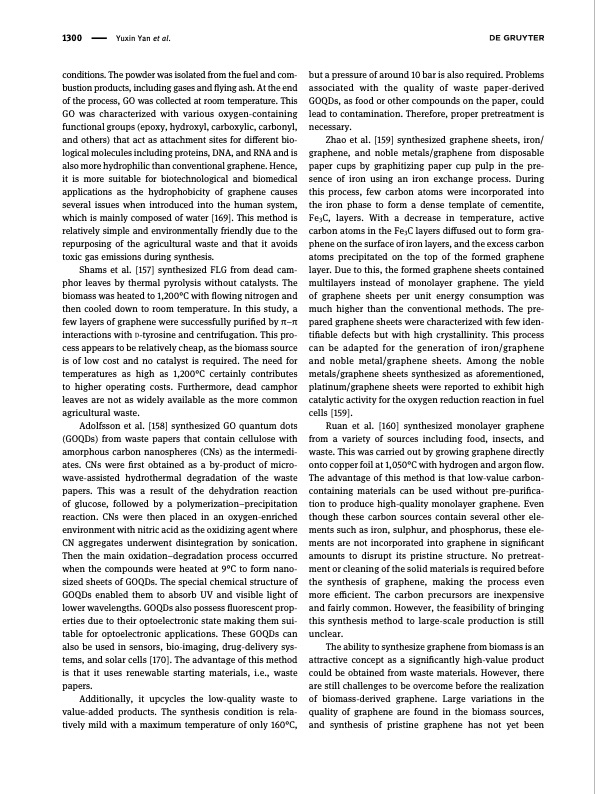PDF Publication Title:
Text from PDF Page: 017
1300 Yuxin Yan et al. conditions. The powder was isolated from the fuel and com- bustion products, including gases and flying ash. At the end of the process, GO was collected at room temperature. This GO was characterized with various oxygen-containing functional groups (epoxy, hydroxyl, carboxylic, carbonyl, and others) that act as attachment sites for different bio- logical molecules including proteins, DNA, and RNA and is also more hydrophilic than conventional graphene. Hence, it is more suitable for biotechnological and biomedical applications as the hydrophobicity of graphene causes several issues when introduced into the human system, which is mainly composed of water [169]. This method is relatively simple and environmentally friendly due to the repurposing of the agricultural waste and that it avoids toxic gas emissions during synthesis. Shams et al. [157] synthesized FLG from dead cam- phor leaves by thermal pyrolysis without catalysts. The biomass was heated to 1,200°C with flowing nitrogen and then cooled down to room temperature. In this study, a few layers of graphene were successfully purified by π–π interactions with D-tyrosine and centrifugation. This pro- cess appears to be relatively cheap, as the biomass source is of low cost and no catalyst is required. The need for temperatures as high as 1,200°C certainly contributes to higher operating costs. Furthermore, dead camphor leaves are not as widely available as the more common agricultural waste. Adolfsson et al. [158] synthesized GO quantum dots (GOQDs) from waste papers that contain cellulose with amorphous carbon nanospheres (CNs) as the intermedi- ates. CNs were first obtained as a by-product of micro- wave-assisted hydrothermal degradation of the waste papers. This was a result of the dehydration reaction of glucose, followed by a polymerization–precipitation reaction. CNs were then placed in an oxygen-enriched environment with nitric acid as the oxidizing agent where CN aggregates underwent disintegration by sonication. Then the main oxidation–degradation process occurred when the compounds were heated at 9°C to form nano- sized sheets of GOQDs. The special chemical structure of GOQDs enabled them to absorb UV and visible light of lower wavelengths. GOQDs also possess fluorescent prop- erties due to their optoelectronic state making them sui- table for optoelectronic applications. These GOQDs can also be used in sensors, bio-imaging, drug-delivery sys- tems, and solar cells [170]. The advantage of this method is that it uses renewable starting materials, i.e., waste papers. Additionally, it upcycles the low-quality waste to value-added products. The synthesis condition is rela- tively mild with a maximum temperature of only 160°C, but a pressure of around 10 bar is also required. Problems associated with the quality of waste paper-derived GOQDs, as food or other compounds on the paper, could lead to contamination. Therefore, proper pretreatment is necessary. Zhao et al. [159] synthesized graphene sheets, iron/ graphene, and noble metals/graphene from disposable paper cups by graphitizing paper cup pulp in the pre- sence of iron using an iron exchange process. During this process, few carbon atoms were incorporated into the iron phase to form a dense template of cementite, Fe3C, layers. With a decrease in temperature, active carbon atoms in the Fe3C layers diffused out to form gra- phene on the surface of iron layers, and the excess carbon atoms precipitated on the top of the formed graphene layer. Due to this, the formed graphene sheets contained multilayers instead of monolayer graphene. The yield of graphene sheets per unit energy consumption was much higher than the conventional methods. The pre- pared graphene sheets were characterized with few iden- tifiable defects but with high crystallinity. This process can be adapted for the generation of iron/graphene and noble metal/graphene sheets. Among the noble metals/graphene sheets synthesized as aforementioned, platinum/graphene sheets were reported to exhibit high catalytic activity for the oxygen reduction reaction in fuel cells [159]. Ruan et al. [160] synthesized monolayer graphene from a variety of sources including food, insects, and waste. This was carried out by growing graphene directly onto copper foil at 1,050°C with hydrogen and argon flow. The advantage of this method is that low-value carbon- containing materials can be used without pre-purifica- tion to produce high-quality monolayer graphene. Even though these carbon sources contain several other ele- ments such as iron, sulphur, and phosphorus, these ele- ments are not incorporated into graphene in significant amounts to disrupt its pristine structure. No pretreat- ment or cleaning of the solid materials is required before the synthesis of graphene, making the process even more efficient. The carbon precursors are inexpensive and fairly common. However, the feasibility of bringing this synthesis method to large-scale production is still unclear. The ability to synthesize graphene from biomass is an attractive concept as a significantly high-value product could be obtained from waste materials. However, there are still challenges to be overcome before the realization of biomass-derived graphene. Large variations in the quality of graphene are found in the biomass sources, and synthesis of pristine graphene has not yet beenPDF Image | Synthesis of graphene Potential carbon precursors

PDF Search Title:
Synthesis of graphene Potential carbon precursorsOriginal File Name Searched:
10-1515-ntrev-2020-0100.pdfDIY PDF Search: Google It | Yahoo | Bing
Salgenx Redox Flow Battery Technology: Power up your energy storage game with Salgenx Salt Water Battery. With its advanced technology, the flow battery provides reliable, scalable, and sustainable energy storage for utility-scale projects. Upgrade to a Salgenx flow battery today and take control of your energy future.
CONTACT TEL: 608-238-6001 Email: greg@infinityturbine.com (Standard Web Page)